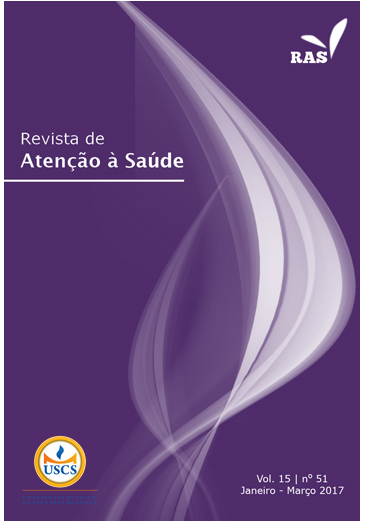Hemoglobinopathies in pregnant women submitted to the mommy test in the Brazilian public health network
DOI:
https://doi.org/10.13037/ras.vol15n51.4266Keywords:
Hemoglobin SC Disease, Sickle Cell Trait, Sickle Cell Hemoglobin, Sickle Cell AnemiaAbstract
Introduction: The hemoglobinopathies are among genetic diseases of great importance in the world. Approximately 7% of the global population have some kind of hemoglobinopathy, and estimates show that about 300,000 to 400,000 children affected by these disorders are born each year. Objective: To describe prevalent diagnoses of hemoglobinopathies in pregnant women submitted to the Mommy Test in the Brazilian public health network. Methods: Cross-sectional, descriptive study with quantitative analysis of the data. The sample included 1,013 electronic medical records of pregnant users of the public health network of the municipality of Pinhais, state of Paraná, Brazil, recorded between February 25th, 2014 and February 25th, 2015. Medical records of pregnant women undergoing up until the third quarter of pregnancy submitted to the Mommy Test were used. Results: It was observed that 55.7% of the pregnant women were submitted to the Mommy Test in their first quarter. Only 0.7% of the results of the test showed the Hemoglobin C trait, and 1.3% presented sickle cell trait. As for race, in the results that showed alterations (n=20), 50% of the women were white, 40% were brown, and 10% were black. Among these participants, 80% presented intercurrences during the pregnancy, the most frequent being urinary tract infection (50%), general leucorrhea (25%), and intercurrences during delivery (12.5%). Conclusion: A low prevalence of hemoglobinopathies was observed in this study. The implementation of the Mommy test in the Brazilian public health network is recommended for early diagnosis of gestational hemoglobinopathies.
Downloads
References
Carlos AM, Souza RAV, Souza BMB, Pereira GA, Tostes JS, Martins PRJ, et al. Hemoglobinopathies in newborns in the southern region of the Triângulo Mineiro, Brazil. Cross-sectional study. Sao Paulo Med J. 2015;133(5):439-44.
Dos Santos PND, Freire MHS, Zanlorenzi GB, Pianovski MA, Denardi MAFV. Anemia falciforme: caracterização dos pacientes atendidos em um ambulatório de referência. Cogitare Enferm. 2014;19(4):755-93.
Tavares CFF, Guimarães JDS, Souza AM. Prevalence of hemoglobinopathies in school children: the importance of using confirmatory methods. Braz J Pharm Sci. 2015;51(2):361-6.
Viana-Baraciol LM, Bonini-Domingos CR, Pagliusi RA, Naoum PC. Prevenção de hemoglobinopatias a partir do estudo em gestantes. Rev Bras Hematol Hemoter. 2001;23(1):31-9.
Brasil. Ministério da Saúde. Secretaria de Atenção à Saúde. Departamento de Atenção Especializada. Manual de educação em saúde: Linha de cuidado em doença falciforme [Internet]. Brasília, DF: 2009 [citado em 2016 abr 10]. Disponível em: http://bvsms.saude.gov.br/bvs/publicacoes/manual_educacao_saude_v2.pdf
Brasil. Ministério da Saúde. Secretaria de Atenção à Saúde. Departamento de Atenção Especializada. Coordenação da Política Nacional de Sangue e Homoderivados. Manual de Condutas Básicas na Doença Falciforme [Internet]. Brasília, DF: 2006 [citado em 2017 mar 3]. Disponível em: http://www.riocomsaude.rj.gov.br/Publico/MostrarArquivo.aspx?C=Y0%2BUl9IsUXc%3D
Paraná. Comissão Intergestores Bipartite do Paraná. Deliberação nº 330, de 28 de novembro de 2012. Aprova a realização do exame eletroforense de hemoglobina para os municípios que aderiram a Rede Mãe Paranaense. Curitiba, 2012.
Paraná. Secretaria de Estado de Saúde. Lei Estadual nº 867/1987. Torna obrigatório o Teste do Pezinho em todos os recém-nascidos do estado. Curitiba, 1987.
Alves AC, Da Silva FC, Oselame GB, Neves EB. Prevalência de pólipos colorretais em pacientes submetidos à colonoscopia em Curitiba, Brasil. Rev Bras Med. 2014;71(10).
Gil AC. Métodos e técnicas de pesquisa social. São Paulo: Atlas; 2010.
Brasil. Ministério da Saúde. Departamento de Ações Programáticas Estratégicas. Secretaria de Atenção à Saúde. Pré-natal e puerpério: atenção qualificada e humanizada: manual técnico. Brasília, DF: Ministério da Saúde; 2005.
Brasil. Ministério da Saúde. Conselho Nacional de Saúde. Resolução nº 466, de 12 de dezembro de 2012. Estabelece normas reguladoras para pesquisas e testes em seres humanos. Diário Oficial da União. Brasília, DF; 13 jun. 2013. Seção 1, p. 59.
Dos Santos ADP, Oselame GB, De Almeida DD, Da Silva TAA, De Oliveira EM. Caracterização de gestantes em atendimento pré-natal. Rev da Universidade Vale do Rio Verde. 2015;13(2):630-8.
De Galiza NGC, Da Silva PM. Aspectos moleculares da anemia falciforme. J Bras de Patologia e Med Lab. 2003;39(1):51-6.
Secretaria de Atenção à Saúde. Ministério da Saúde. Manual de normas técnicas e rotinas operacionais do Programa Nacional de Triagem Neonatal. Ministério da Saúde Brasília, DF: 2002.
Nomura RMY, Igai AMK, Tosta K, Fonseca GHHD, Gualandro SFM, Zugaib M. Resultados maternos e perinatais em gestações complicadas por doenças falciformes. Rev Bras Ginecol Obstet. 2010;32(8):405-11.
Dos Santos TN, Barbosa MC, Dos Santos TEDJ, Damasceno D, Diniz S, Lemos VP. Triagem para hemoglobinas variantes em população adulta no Estado do Ceará. Revista Guará. 2015;1(3):131-9.
Nascimento MDLP. Abortos em mulheres portadoras de hemoglobina S (AS). Rev Bras Hematol Hemoter. 2000;22(3):424-.
Ramalho AS, Silva ID, Pagotti M, Teixeira RC. Abortamentos espontâneos em portadoras do Traço Falciforme (AS). Rev bras hematol hemoter. 2003;25(4):265-6.
Silva CA, Baldim LB, Nhoncanse GC, Estevão IF, Melo DG. Neonatal screening program for hemoglobinopathies in the city of São Carlos, state of São Paulo, Brazil: analysis of a series of cases. Revista Paulista de Pediatria. 2015;33(1):19-27.
Downloads
Published
Issue
Section
License
Policy Proposal for Journals offering Free Delayed Access
Authors who publish in this magazine agree to the following terms:
- Authors maintain the copyright and grant the journal the right to the first publication, with the work simultaneously licensed under a Creative Commons Attribution License after publication, allowing the sharing of the work with recognition of the authorship of the work and initial publication in this journal.
- Authors are authorized to assume additional contracts separately, for non-exclusive distribution of the version of the work published in this magazine (eg, publishing in institutional repository or as a book chapter), with the acknowledgment of the authorship and initial publication in this journal.
- Authors are allowed and encouraged to publish and distribute their work online (eg in institutional repositories or on their personal page) at any point before or during the editorial process, as this can generate productive changes, as well as increase impact and citation of the published work (See The Effect of Open Access).









